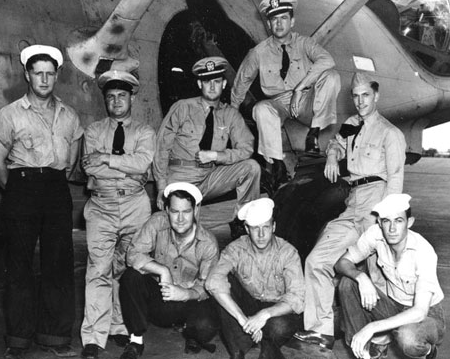With the Golden Pelicans, 1942

(The crew of the PBY Catalina that sighted the Japanese fleet on the eve of the Battle of Midway).
All the ceremonies surrounding the anniversary of the Battle of Midway are kicking off today. The vast distances involved meant that the epic struggle would play out over a week. In the parlance of today’s warfighters, the “battlespace had been shaped” by the codebreakers of Station Hypo, the information had been passed cogently to the Commander of the Fleet, Chester Nimitz by Intel chief Eddie Layton, forces had been allocated and deployed after heroic efforts by the military and civilian workers at Pearl Harbor Naval Shipyard. The haze-gray combat forces were moving to engage the enemy. The die was cast, and all the Spooks could do in their Dungeon under the 14th Naval District Headquarters was to wait, and hope their analysis had been right.
The celebrations may include tours of The Dungeon, since it is now a space controlled by the Bureau of Reactors and normally under tight control. Our pal Mac Showers would have appreciated people being able to see where he sat under the watchful gaze of Joe Rochefort, and adjacent to retired submariner and pulp fiction writer Jasper Holmes, and just a spitwad shot distance from Tommie Dyer, who had been working the Japanese code problem since the mid-1930s.
The Navy knows the curse of distance, and hence the Department’s major observation, is going to be the largest of them, and not in Hawaii. All the brass is going to be there as well to commemorate the greatest maritime victory since Trafalgar.
It is a little bittersweet. I had intended a two years ago to be on a jet headed west around this time today, heading not for the Golden State but for the lovely isle of O’ahu to celebrate with my son, and the various ghosts I have acquired through the years.
Some of them are anonymous, or at least unknown to me and my shipmates who shared the Haunted Bunk Room at the Ford Island Dispensary and which had been the temporary morgue after the attack.
And of course the ones I knew best over a decade of conversation at the bar of the Willow Restaurant. It now seems like a magical time in life. I even had tickets to be at the 70th anniversary with Mac and his family, but I wound up in the hospital instead with the firm admonition not to sit in one place for very long due to the risk of blood clots.
I thought I would start the cycle with an account of a visit to Midway itself, and the remembrance of one of the heroes, the lone survivor of Torpedo Squadron EIGHT, Ensign George Gay. I met George once. He was a good guy, and I bought his book, not knowing the connection he had to Station HYPO- and was the perfect cover for the true story of Operational Intelligence (OPINTEL) and victory at sea.
My 93-year-old drinking buddy Mac was one of the last survivors, and considering the significance of the anniversary of the great battle, and the fact that so few of the participants are left, Mac took his family out there. My boss Jake was been asked to make a speech, along with the Director of National Intelligence.
Jake had an interesting story and he began to tell it as he wagged a finger at Liz-with-an-S behind the bar for another glass of golden IPA.
He had made one-star while on what we called then the USCINCPAC Staff, and was the “duty Admiral” one weekend when a special flight was laid on to scatter the ashes of ENS George Gay, (the “Sole Survivor of Torpedo EIGHT”) from the CINC’s dedicated P-3 Orion aircraft on the waves where the battle was fought so long ago. After he was shot down with the rest of his squadron, he spent an eventful day amid the burning Japanese fleet. It was Gay’s colorful eyewitness account of the sinking of three IJN Carriers that electrified the nation on the cover of Life Magazine.
Of course, it wasn’t completely true. Gay’s story was useful in that it provided an alternative explanation to why Admiral Nimitz knew so much about the devastating results of the battle rather than disclosing that we were reading their naval messages. George had a colorful story that did not include the details of the vulnerability of the JN-25 coding system used by the Japanese.
I met ENS Gay at one of the big EAA fly-ins at Oshkosh years ago, and he signed a copy of his book about the battle for me, “Sole Survivor.” He actually made LCDR before the war was over, and despite a follow-on career flying for Trans World Airways, he would always be “ENS Gay,” the only one of thirty squadron mates to survive the battle- though of course there is some qualification to that.
I wish I had known the real story and asked him to hear it direct from the horse’s mouth.
Copyright 2019 Vic Socotra
www.vicsocotra.com
